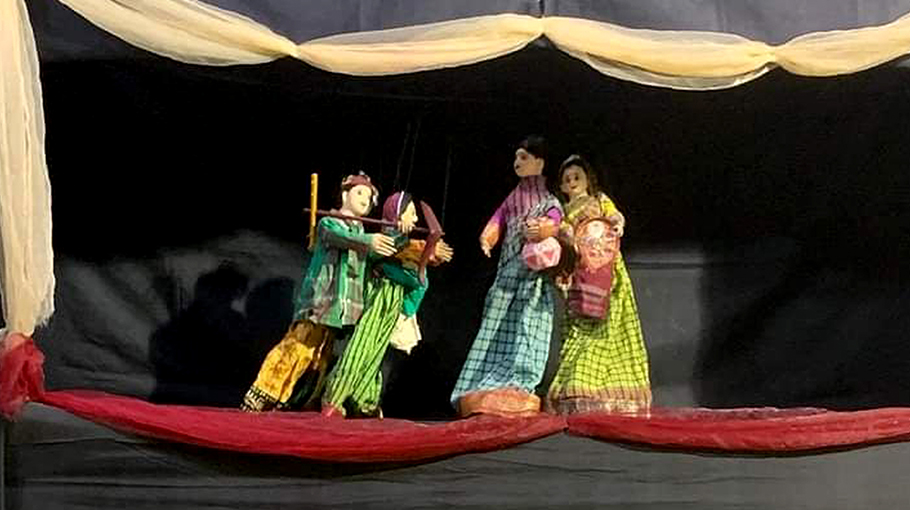Puppet shows disappearing from rural area, artisan seeks govt help

The puppet dance of Nabinagar in Brahmanbaria is an ancient tradition of Bangladesh and the Indian subcontinent. Once upon a time puppet dance played an important role in the entertainment of the young and old in rural towns, especially in the entertainment of children. Krishnanagar is an ancient town built on the banks of Titus in Nabinagar Upazila of Brahmanbaria district, which is the source point of puppet dance art.
Ustad Bipin Das, the father of puppet dance of the Indian subcontinent, was born in this village on December 31, 1879 in the house of his father Vrindavan Das. Even though he was born as the only child of his parents, he spent his childhood and adolescence learning basic education. At that time, boats and ships loaded with jewelery and goods used to come and go to Calcutta via Narayanganj from Montala Ghat. Many people call him Bipin Majhi as Bipin Das also worked for some time with his grandfather Gagan Das who was in charge of these ships.
Seeing dolls made of clay in his youth, he dreamed that if these dolls could be danced, then many things could be said in the rhythm of the dance. Bipin Pal of Krishnanagar village in Nabinagar in the Indian subcontinent introduced the first modern puppet dance. Bipin Pal is said to have danced puppets based on mythological stories considering the social context of the time. Apart from this, various scenes of rural life are highlighted in it. Sometimes Kathuria is depicted as being attacked by tigers, or the tragic outcome of fishermen being eaten by crocodiles. The presence of people from all walks of life, from children to the elderly, was a sight to behold.
There was no limit to the joy of children watching puppet dance, from this idea he first started making clay puppets, gods and goddesses in various shapes and gradually made stick puppets, spring puppets and thread puppets. He along with some disciples from the same area created a spectacle by creating puppet dances. Seeing the huge popularity, along with his family, Moti Mia, Ramnath Babu, Tarumia and Siddique Mia increased the promotion and spread of puppet dance. His disciples stayed with the master for many years and later formed puppet dance groups in different areas. Once upon a time, Meddar Dhan Mia, Kalu Mia, Raj Hossain, Sharif Maldar of Kazipara and a few houses of Kandpara were greatly influenced by the charm of puppet dance and created a puppet dance troupe themselves and made this puppet dance troupe popular throughout the country including Brahmanbaria, Comilla, Mymensingh, Narsingdi, Bikrampur, Sylhet, Noakhali, Chittagong. Apart from that, at that time in some areas of Faridpur and Rajshahi regions, the practice and popularity of puppet dance was creating a stir.
Bipin Das accompanied his two sons Gopal Das and Govinda Das to teach this profession and they also became masters and spread the puppet dance all over India. Ustad Gopal Das went to India under the direction of his father Bipin Das and made numerous disciples in different areas to form and introduce puppet dance troupes. As a result, its wide popularity and fame with the introduction of Bipin Das increased throughout India. Not only India, he traveled to around 27 countries of the world with puppet dance troupes. Ustad Gobind Das along with his father tried to promote Kanache puppet dance all over the then East Pakistan and independent Bangladesh and formed groups to introduce it. Ustad Gobind Das initiated his son Badal Das into this profession and has been conducting his activities till today with three puppet dance troupes named "The Royal Bengal Puppet Dance", "Sajher Bati Puppet Dance" and "Sandhyamalati".
Bipin Das was quite adept at using various musical instruments and playing musical instruments. He could play numerous musical instruments including sitar, harmonium, tabla, mudi patil - jhala. He made several silent films during the British rule. Bipin Das was the pioneer and guide of this huge popularization of folk culture of rural Bengal.
From behind the screen, he wanted to influence the latent thoughts of the society and people of that time to create awareness by highlighting various important issues through good-bad, happiness-sadness, laughter-crying in his own creativity.
Currently puppet dance is facing many obstacles due to obscene dance songs, the administration generally does not allow these programs.
Because different people sing vulgar dance in the name of puppet dance at different times. The members of the puppet dance group demand that the government should help and protect this industry.




